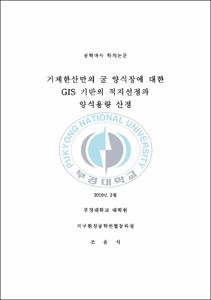거제한산만의 굴 양식장에 대한 GIS 기반의 적지선정과 양식용량 산정
- Alternative Title
- GIS-based Site Selection and Carrying Capacity Assessment for Oyster Culture in GeojeHansan Bay
- Abstract
- GIS-based site selection and carrying capacity assessment for oyster culture can propose a solution for sustainability and systematic management. Site selection is a key factor in the aquaculture operation, affecting both success and sustainability and can solve conflicts between different activities, making a rational use of the coastal space. It could be obtained by GIS-based habitat suitability index, which was developed by USFWS. Estimating the carrying capacity of an area for oyster culture can be classified into four hierarchical categories, according to their level of complexity and scope, such as physical, production, ecological, and social carrying capacity. Most scientific effort to date has been directed towards modelling production carrying capacity and some of the resulting models have been used successfully. In case of ecological carrying capacity, the modelling of it is still in its infancy, because it has to consider all aspects of the interactions with other resources.
As an alternative, there is a requirement for a set of ecological indicators for assessing the ecological performance of oyster cultures. After GIS-based site selection in GeojeHansan Bay, this study tried the estimating of ecological carrying capacity using ecological indicators. Clearance efficiency indicator showed the value of 0.331 which could represent the clearing ability by oyster cultures in GeojeHansan Bay. Filtration pressure indicator showed the value of 0.203 which could provide a guidance on the present level of culture development in regard to production and ecological carrying capacity in GeojeHansan Bay.
According to the environmental characteristics and the present oyster cultures in GeojeHansan Bay, the newly assessed filtration pressure for the acceptable ecological carrying capacity was 0.102. Consequently, ecological carrying capacity in GeojeHansan Bay was 2,480 M/T, 25 ind./m3 and this represents the level of culture that can be introduced into GeojeHansan Bay without leading to significant changes to ecological process, species, populations or communities.
- Issued Date
- 2010
- Awarded Date
- 2010. 2
- Type
- Dissertation
- Publisher
- 부경대학교
- Alternative Author(s)
- Yoon-sik Cho
- Affiliation
- 부경대학교 대학원 지구환경공학연협동과정
- Department
- 대학원 지구환경공학학ㆍ연협동과정
- Advisor
- 이석모
- Table Of Contents
- I. 서 론 1
II. 이론적 배경 5
1. 우리나라 굴 양식 산업 5
가. 굴 양식 산업의 현황 5
나. 우리나라 굴 양식 산업의 문제점 11
2. 지리정보시스템의 활용 14
가. 양식장의 공간결정 지원을 위한 지리정보시스템의 활용 14
나. 지리정보시스템의 양식장 활용 사례 분석 29
3. 양식장 환경용량 산정 개념의 발전과 Ecological Indicator 44
가. 양식장 환경용량 산정 개념의 발전 44
나. Ecological Indicator 46
III. 연구방법 49
1. 대상해역 49
2. 적지 선정을 위한 Habitat Suitability Index 51
3. 양식용량 산정 56
가. Clearance Efficiency 56
나. Filtration Pressure 56
4. 최적지에 따른 입식밀도 산정 57
IV. 결과 및 고찰 58
1. 지리정보시스템을 이용한 거제한산만의 적지 선정 58
가. 거제한산만의 Habitat Suitability Index 58
나. 지리정보시스템을 이용한 거제한산만의 적지 선정 66
다. Habitat Suitability Index 검증 83
2. 거제한산만의 양식용량 산정 88
가. 거제한산만의 어장구역 분할 88
나. 거제한산만의 Clearance Efficiency 90
다. 거제한산만의 어장구역별 Clearance Efficiency 96
라. 거제한산만의 Filtration Pressure 100
마. 거제한산만의 어장구역별 Filtration Pressure 107
바. Ecological Indicator를 이용한 양식용량 산정 109
3. 거제한산만의 최적지에 따른 최적입식밀도 산정 114
V. 결 론 118
참 고 문 헌 121
감사의 글 132
- Degree
- Doctor
- Appears in Collections:
- 대학원 > 지구환경공학연협동과정
- Files in This Item:
-
-
Download
 거제한산만의 굴 양식장에 대한 GIS 기반의 적지선정과 양식용량 산정.pdf
기타 데이터 / 4.49 MB / Adobe PDF
거제한산만의 굴 양식장에 대한 GIS 기반의 적지선정과 양식용량 산정.pdf
기타 데이터 / 4.49 MB / Adobe PDF
-
Items in Repository are protected by copyright, with all rights reserved, unless otherwise indicated.